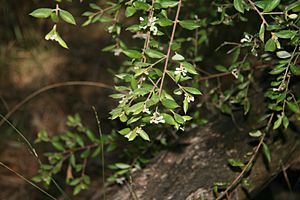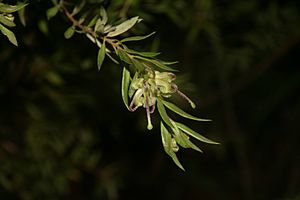Green spider flower facts for kids
Quick facts for kids Green spider flower |
|
|---|---|
 |
|
| In bud, Georges River National Park | |
| Scientific classification | |
| Genus: |
Grevillea
|
| Species: |
mucronulata
|
| Synonyms | |
|
Embothrium acuminatum (R.Br.) Dum.Cours.
|
|
The Grevillea mucronulata, also known as the green spider flower or green grevillea, is a type of shrub. It belongs to the plant family Proteaceae. This plant is special because it only grows naturally in New South Wales, Australia. A scientist named Robert Brown first described it in 1810. You can find it in open sclerophyll forests or woodlands around the Sydney area and the south coast of New South Wales. It grows as a small bush, up to 3 metres (about 10 feet) tall and wide. Its leaves can look different, and its greenish flowers bloom during the cooler months, from May to October. Birds really like these flowers.
Contents
About the Green Spider Flower
How the Green Spider Flower Got Its Name
The green spider flower was first found by Joseph Banks in April 1770 at Botany Bay. This makes it the very first plant of its kind (genus) to be discovered! A Scottish scientist named Robert Brown officially described the species in his book in 1810. The name mucronulata comes from a Latin word meaning "with a small point." This refers to the tiny pointed tip on the plant's leaves.
Robert Brown also described other plants like Grevillea cinerea and Grevillea acuminata. Later, scientists realized these were actually the same species as Grevillea mucronulata.
Sometimes, different types of grevillea plants can mix together. This can happen when the green spider flower grows near other cultivated grevilleas, like the Rosemary grevillea. When they mix, they create new plants that are a combination of both. These new plants can sometimes be found growing by roadsides. The green spider flower can also naturally mix with other wild species, like the Prickly spider-flower.
The green spider flower is closely related to another plant called Grevillea kedumbensis. That plant has rougher leaves and different flower parts.
What the Green Spider Flower Looks Like

This plant is a bush that can spread out or grow straight up. It usually reaches a height of 0.3 to 3 metres (about 1 to 10 feet). Its leaves can vary a lot in shape. They might be narrow and oval, or almost round. They are usually between 0.5 and 4 centimetres (0.2–1.5 inches) long and 0.2–1.8 centimetres (0.1–0.7 inches) wide.
The green flowers grow in groups called inflorescences. These flower groups mostly appear from late autumn to mid-spring (May to October in Australia). Each group has 6 to 18 individual flowers and is about 2.5–5.5 centimetres (1–2.3 inches) long. They can make a lot of sweet liquid called nectar. The flower parts (called the perianth) are pale green or yellow-green and covered in fine hairs. They are about 0.8–1.7 centimetres long. The long, thin part of the flower (called the style) is red or maroon. It has a green tip that holds the pollen. The flower parts get darker as they get older.
Scientists have noticed a few different forms of this plant, but they are all still considered the same species for now.
- The 'typical form' is found north of the Lower Blue Mountains. It's a single-stemmed bush with oval leaves that have a pointed end. This form grows back from seeds after a fire.
- The Cumberland Plain form grows on heavier soils in Sydney's northwest. It's a smaller bush, about 30 centimetres (12 inches) tall, with small, round leaves. This form has a special woody swelling at its base (a lignotuber) that helps it regrow after a fire.
- The large-leaved form is found south of Botany Bay. It has bigger, oval leaves that can be papery or leathery. Its flowers are larger and very hairy.
- The Picton form has narrow, oval leaves and smaller flower groups. This form looks a lot like G. kedumbrensis and might be classified as a different plant in the future.
Where the Green Spider Flower Lives
The green spider flower grows in the upper Hunter Region, around Sydney, and south along the coast towards Eden. It can be found from sea level up to 800 metres (about 2500 feet) high. It likes soils that don't have many nutrients, from sandy to clay-like. These soils are usually based on sandstone or shale, and sometimes granite.
You can find this plant in dry sclerophyll forests. It grows under trees like the Sydney red gum, blue leaved stringybark, Sydney peppermint, red bloodwood, and New South Wales Christmas bush. It also grows in more open woodlands under trees like scribbly gum or small-leaved apple.
How the Green Spider Flower Interacts with Nature
The flowers of the green spider flower seem to be designed to be pollinated by birds. The part of the flower that holds pollen is quite far from the petals. Birds like the eastern spinebill and the New Holland honeyeater visit the flowers in the early morning and late afternoon to find food. Honeybees also visit later in the day, but they don't seem to be very good at pollinating these flowers.
Growing Green Spider Flowers
Even though its green flowers can be hard to see among the leaves, this plant is still popular for gardens. Its flowers attract birds and bloom for a long time. The leaves and new bronze-colored growth also make it a nice plant to look at. It can grow well in sunny spots or in areas with some shade.
It's easy to grow new green spider flowers from seeds or by taking cuttings. Seeds usually sprout in 30 to 40 days. Sometimes, treating the seeds with smoke can make them sprout a little faster. It's good to know that many green spider plants sold in stores might be mixed types (hybrids) rather than pure G. mucronulata.
See also
 In Spanish: Grevillea mucronulata para niños
In Spanish: Grevillea mucronulata para niños

